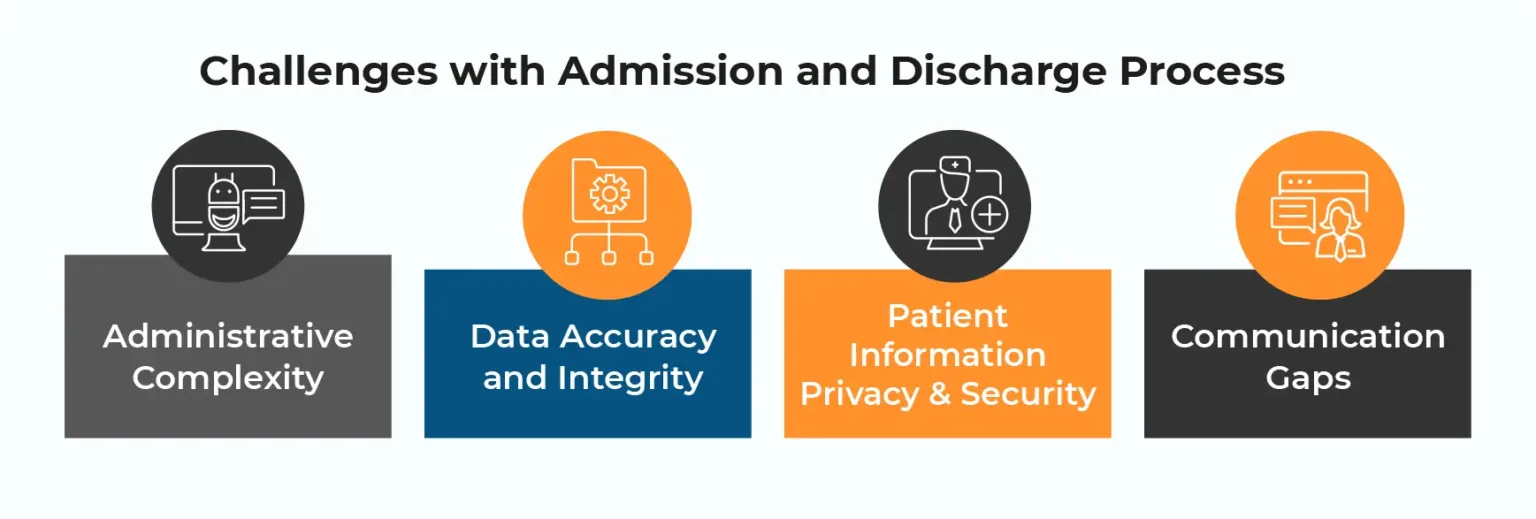Implementing automation in healthcare process has been fruitful for healthcare industries due to the repetitive nature of the process. Using automation, healthcare providers can achieve an 80% reduction in helpdesk overload. Yes, the numbers are real indeed. Previously, we talked about the role of RPA in patient scheduling.
Here we are again going to explore how automation can help healthcare providers automate the admission and discharge process and offer on-time patient care.
Understanding Admission and Discharge Process in Healthcare
The admission and discharge processes in healthcare are critical administrative and clinical procedures that occur when a patient enters a healthcare facility (e.g., hospital) for treatment or is discharged after receiving care. These processes involve various steps and interactions among healthcare providers, patients, and administrative staff. Let’s take an overview of the admission and discharge process.
- The admission process in healthcare involves multiple steps like patient registration, medical record review, admission orders, medical assessment of current condition and offering treatment.
- On the other hand, the discharge process in healthcare includes a series of steps like medical treatment review, discharge planning, flagging high-priority discharge cases and follow-up with the patients post-discharge.
Challenges with Admission and Discharge Process
The admission and discharge processes in healthcare are critical for the efficient functioning of healthcare facilities and ensuring high-quality patient care. However, they come with several challenges that healthcare providers must navigate. Here are some of the key challenges associated with the admission and discharge processes in healthcare:

-
Administrative Complexity
The admission and discharge processes involve a multitude of administrative tasks, including paperwork, data entry, patient registration forms, and documentation. Managing these administrative aspects can be time-consuming and prone to errors.
-
Data Accuracy and Integrity
Ensuring the accuracy and integrity of patient data is crucial during admission and discharge. Any errors or discrepancies in patient information can lead to medical errors, billing issues, and compromised patient safety.
-
Patient Information Privacy and Security
Healthcare providers must adhere to strict regulations such as the Health Insurance Portability and Accountability Act (HIPAA) to protect patient data. Maintaining data privacy and security throughout the admission and discharge processes is a significant challenge.
-
Communication Gaps
Effective communication among healthcare providers, patients, and their families is essential for a smooth admission and discharge process. Miscommunication or lack of coordination can lead to misunderstandings and potentially compromise patient care.
Addressing these challenges requires a multifaceted approach that combines effective communication, streamlined processes, the use of technology (such as Electronic Health Records and healthcare management systems), and robotics automation solutions that not only enhance patient care but also contribute to the overall efficiency and effectiveness of healthcare delivery.
How AutomationEdge Hyperautomation Solution can Simplify the Admission and Discharge Process?
AutomationEdge hyperautomation solution contains a pool of technologies like RPA, AI, Intelligent Document Processing, Conversational AI and others. Integrating these technologies into the healthcare system can make the admission and discharge process for healthcare providers a lot easier. Instead of manually handling the data involved in the admission and discharge process, an AI chatbot integrated with Intelligent document processing can take care of all the tasks related to data. Let’s understand how the automated admission and discharge process works-
Admission and Discharge Process with AutomationEdge RPA
-
-
- As soon as the patient is registered, the AI bot verifies and upload medical record in the EHR system
- Share health records with the physician for medical diagnosis
- Once the diagnosis is completed, the bot continuously monitors the patient’s health
- With real-time health monitoring, the bot identifies missing tests if there are any
- Generate alerts for high-priority discharge cases
- Post-discharge track patient’s progress and create alerts for follow-ups and appointments
-
Conclusion
Robotic Process Automation is transforming the healthcare industry by revolutionizing admission and discharge processes. By automating repetitive tasks, reducing errors, and ensuring compliance, RPA in healthcare industry not only enhances operational efficiency but also improves patient care and experiences. While there are challenges in implementation, the long-term benefits make RPA a valuable investment for healthcare institutions looking to streamline their processes and reduce costs while maintaining high-quality care.
Other Articles in this Series
- What is RPA in Healthcare?
- Why Should Healthcare Providers Choose Automated Patient Scheduling?
- How Does Automated Patient Referral Process Work?
- Automating Testing Requests and Report Management in Healthcare
- Transform Patient and CareGiver Experience with Electronic Visit Verification Automation (EVV)
- Improving Electronic Health Record Management with Automation
- Role of Automation in Patient Insurance Eligibility Verification Process
- Simplifying Healthcare Insurance Claims Processing with RPA
- What is Medicare Payment Process Automation in Healthcare?
- Accelerating Revenue Cycle Management with AI-Powered Automation
